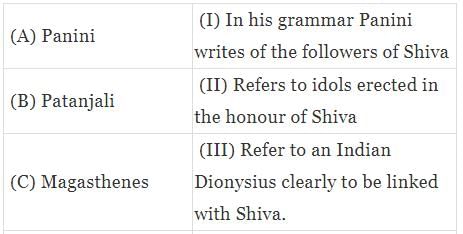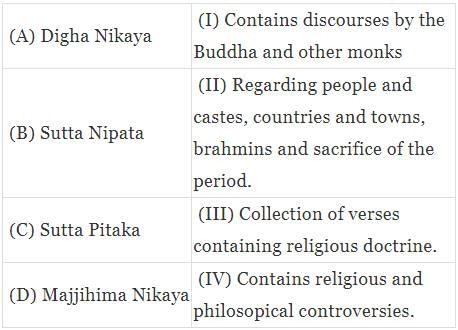Practice Test: Modern India - 1 - UPSC MCQ
30 Questions MCQ Test - Practice Test: Modern India - 1
Gotra, Vis and Jana of the later-Vedic period may be corresponding to which of the following of the Iranian world?
Which of the following directed the ladies to leave the hall of learning where some principles of gynaecology were explained, which are indelicate for the female ear?
There is a trace of Police officials in the Ugras who occur in one passage of the
During the Sangam Age, the Romans are said to have built temple of Augustus at
During the Sangam period which one of the following dynasties sent embassies to Roman emperor Augustus?
Which one of the following is wrongly matched?
I. Isa-Nunukkam—Greatest work of Tamil grammar
II. Padirru-Pattu—One of the part of eight anthologies
III. Thirukural—Supposed to be the fifth veda
IV. Silappadikaram—Extols the virtuous life
Which one of the following dynasties was constantly at war with the Cheras during the later Sangam period?
The names of the Jain Tirthankaras said to have been mentioned in the Rig-veda are
The Pali texts speak of the three types of villages during the Pre-Maurya period. Which of the following is not one of them?
The Statue of Gomateshwara at Sravanabelgola was erected by
The rise of Buddhism can not be explained solely by the persuasive force of a doctrine of overwhelming elevation. What were the socioeconomic transformations then in progress?
Which of the following is correct about the contribution of Buddhism?
I. Created a feeling of political unity, peace and universal brotherhood.
II. Gave the idea of classless society, no accumulation of wealth and development of Apabhramsa.
III. Had a reformatory influence on Hinduism.
IV. Helped in the development of education, literature and had greater influence on art.
Which of the following is responsible for the earliest work in the Apabhramsa and its first grammar?
In which one of the following are the germs of the Bhagavata cult found?
I. Jatakas
II. Vedas
III. Upanishads
IV. Puranas
Who says, “if women was not admitted in the monasteries, Buddism would have continued for thousand of years, but because this admission has been granted it would last only five hundred years”?
Which one of the following is correct regarding the great vows of Jainism?
I. Ahimsa
II. Asteyam
III. Brahmacharyam
IV. Satyam
V. Aparigraha
According to Jainism for the stoppage of the influx of new Karmas and eradication of the old one must
Which one of the following school of philosophy was the main off-shoot of Bhagavatism?
Which one of the following names was not given to Bhagvatism?
Bhagavata Gita is the most popular treatise of Bhagavatism.Which one of the following is the path which led one toattain salvation prescribed by it?
I. Knowledge
II. Action
III. Devotion or Bhakti
There is a reference in Arthashastra about temples built in honour of
After second century A.D. Shaivism was divided into different schools. Which one of the following is one of them?
I. Pasupata
II. Saiva
III. Kapalika
IV. Kalamukha
Match the following:
[Evidences of the spread of Shaivism under the Magadha, Maurya and Shunga relers]

Which of the following is not a Mahajanapada during the sixth century B.C.?
















